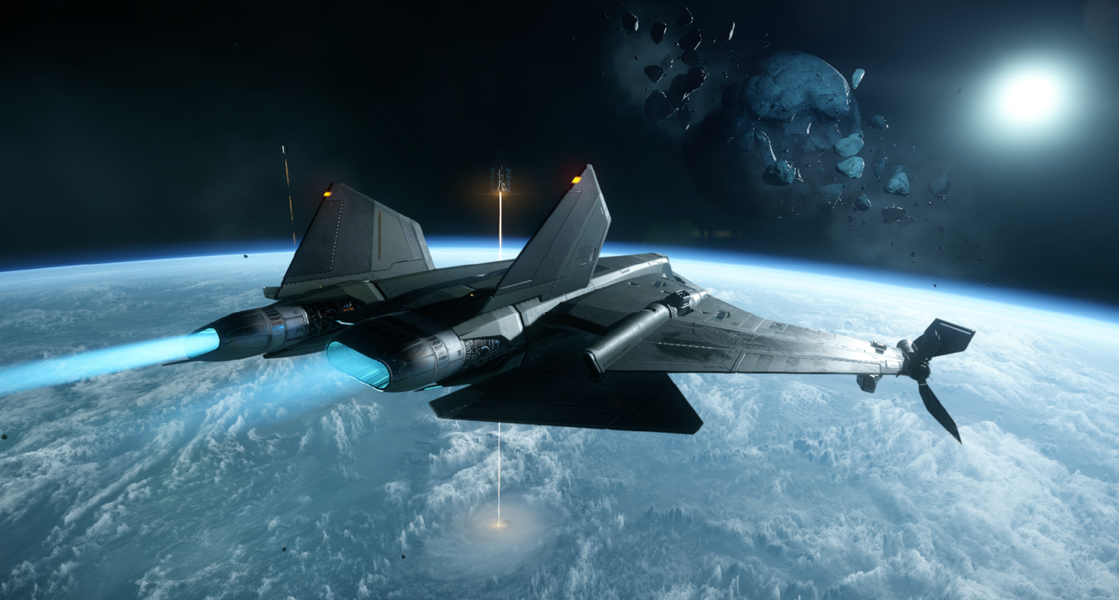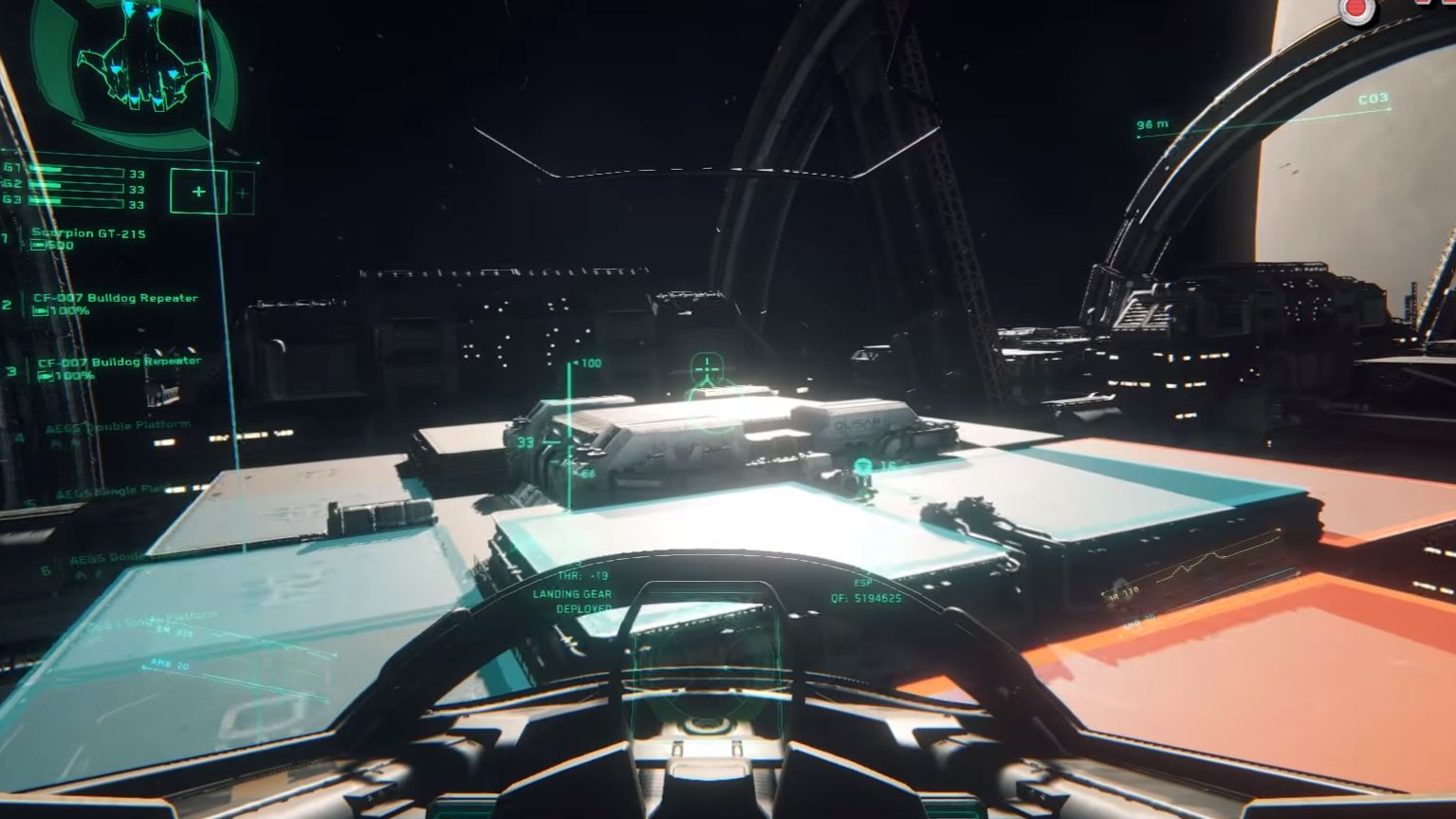Star Citizen 3.0's planetary landing blows No Man's Sky away
Star Citizen is starting to meet the promise of co-op shenanigans in a connected universe.
This week at Gamescom, Roberts Space Industries showed off version 3.0 of Star Citizen, introducing the game's planetary tech. For backers playing Star Citizen in its 2.4 or 2.5 versions, they begin on a space station, and they can cruise around together in some spiffy-looking spaceships, but it's mostly about combat, with a limited sandbox component as well. 3.0, which is coming towards the end of this year, brings the first proper star system in Star Citizen to life, and is a major step towards making this universe feel like a gigantic backdrop.
Within this system, there are four big planets, a smaller planet, space stations and moons, where you can apparently trade, haul cargo or partake in piracy. In this demo, I'm shown the journey from the space station of Port Olisar to a planet called Delamar, with an accompanying crew consisting of developers on the game. While I'm told there'll be a range of missions in this update, some with more templated elements, there are also scripted and voice-acted story missions. Here, we're shown a story mission offered by a guy called Miles Eckhart via a video log, where he invites the viewer to the settlement of Levski on Delamar to take a private security job.
Chris Roberts compares Levski to Mos Eisley: it's where people go when they want to get away from the game's UEE government. The crew climbs into a Freelancer vessel, and the pilot player 'quantum drives' (warps) the ship to Delamar.
On some level, the Star Citizen crowdfunding program has baffled me—the upcoming Squadron 42 looks like a thing I understand, in that it's a single-player game you pay a one-time fee to play. But the Freelancer ship I see in this demo, for example, currently comes with a $148 pledge in Star Citizen's online component, with more expensive rewards besides (although the eventual release will allow you to earn ships in-game without spending real money). I wouldn't personally pay that for any game, or any item in a game. But, I watch this demo of the Freelancer seamlessly warping from the station to the orbit of the light blue-ish planet of Delamar, before burning through the atmosphere, and I can't help feeling like it's showing me an audiovisual quality of space experience I've never seen in a game before. It's immediately impressive. Not so much that I'd pay for a ship that's the price of a whole game to be part of it at this stage, but enough to make me a bit envious of those who do.

The planet is fully rendered, Roberts tells me, with no skybox. The sun is in a fixed position, while the planet moves. On approach, we pass two space stations in quick succession. The level of detail as you near the planet is amazing; the base we're going to, Levski, is a blip of light at first, but the closer you get, the more a real, large-scale environment pulls in. Jagged outlines of rocks and cliffs across the planet's surface become visible. I've seen versions of much of this in other games, but spectacle is the big draw here—and the fact that it's a four-player crew going on a sci-fi adventure, rather than just one. No Man's Sky offers that element of surprise each time you arrive at a new planet, but I've never seen a space sim look this good on a technical level. It makes me excited to see the rest of the planets in the system.
The pilot requests docking permission at Levski, and a video transmission appears on the ship's display, where an NPC gives the okay. He drops the crew off in a hangar and takes off again. Levski is a big, handcrafted environment and each planet will apparently have one unique location like this—with other smaller locales built out of more modular parts. A statue of someone called Anthony Tanaka, killed in a protest against the UEE's Imperator, is one of the first things you see upon exploring Levski. Roberts cites it as an example of the sort of world-building they're doing in the game. This settlement feels lived in, and reminds me a little of Metro: Last Light's few cobbled together, populated locations.
One thing they're keen to show off in version 3.0 is that while you're in the interior of Levski, the rest of the game is still going on for other players, regardless of what they're up to. While the captain demoing the game takes an elevator down to the floor where the mission starts, the pilot flies the Freelancer right up close to the elevator's glass windows in front of the captain just for the hell of it. They make it look like a fun game to dick about in. The pilot even spins the Freelancer around 360 degrees just to show off.
The biggest gaming news, reviews and hardware deals
Keep up to date with the most important stories and the best deals, as picked by the PC Gamer team.

In a sci-fi dive bar, they meet Eckhart from the video transmission earlier, and he outlines a mission to retrieve a black box from a destroyed Starfarer ship. They then travel to an asteroid field near a moon, where they quickly locate the vessel—but also a group of pirates. After a quick and successful dogfight against a few enemy ships, the captain jumps out of the spacecraft and floats through the black until he boards the Starfarer. There are more pirates on-board, as well as the frozen corpses of the crew to push through. In these moments, Star Citizen is functionally a co-op first-person shooter, and again, it's the spectacle that really sets it apart. The asteroid field is a gorgeous, moody sight, and the damaged Starfarer looks like something you might see in Dead Space, with gorgeous sparks from broken ship electronics and swirling debris. Dynamic music cues, too, add underlying drama to your journeys through space.
After taking the black box, the crew is sent to the moon to retrieve the ship's cargo—they just about reach the moon by the time my demo is over, and show me a couple of the ways you can get around on the surface of planets, like a speeder bike-style vehicle and a moon buggy. Star Citizen still has a very long journey ahead, but the move to 3.0 feels like a significant step closer to building an exciting, online sci-fi universe that people will want to spend time in. Even in this form, piling into a ship with a few friends, and taking on missions across gorgeous worlds, might be the sort of thing that'll attract the attention of players outside of the game's existing backers.


